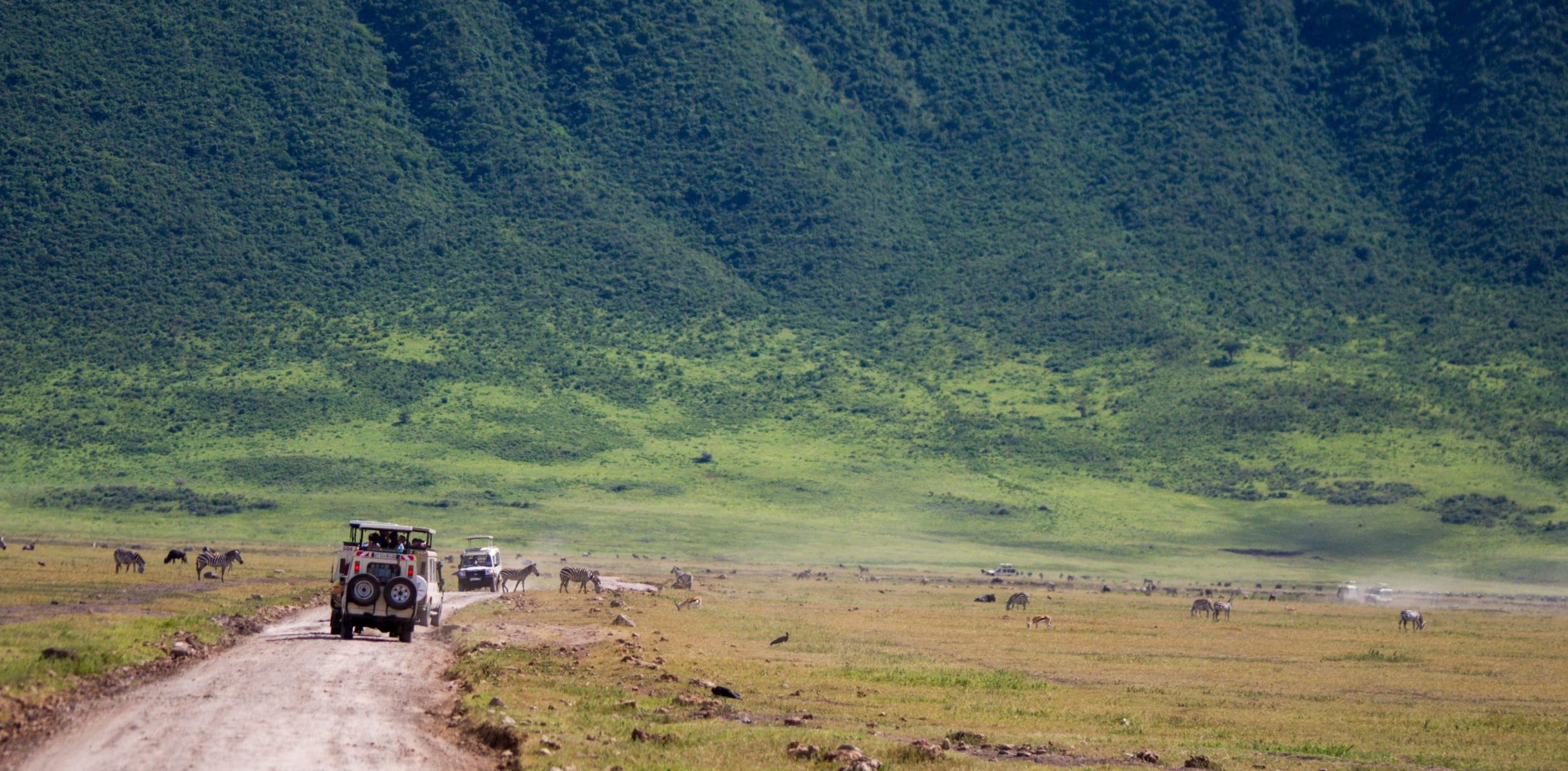Ngorongoro Conservation Area
- Is located in Africa, in the Northern part of Tanzania
- [Covers Around 265 Km²] [ 610Meter Deep]
-
Is world’s Largest, Intact, Unbroken, Unflooded Caldera Formed>>
>>When a Giant Volcano Exploded and Collapsed About to 2-3 Million Years Ago.
- Ngorongoro has also 2 other volcanic craters that Morty and Empakai
-
The Unique Protected Area is officially, 1 of the 7 Natural Wonders of Africa.
-
Has a Complete Unique Formation
Under Unesco World Heritage List
Crater is a Natural Wonder of World
There are 3 Types of Life:
- Life of Maasai
- Life of Livestock
- Life of Wild Animals
Unbelievably all of them are living together, without disturbing one another.
Ngorongoro is actually a Caldera, Not Crater.
-
- Because Craters locate on top of mountains, even is not suitable for to alive living.
- But a Caldera allows living inside.
The Crater is Home for:
- About to 25 Thousand Animals in the crater.
- Strong populations of Maasai Lions, Leopards
- A healthy population of Endangered Black Rhinos
- Some of the largest Toscan Elephants that nowadays already left in Africa
- Herds of Wildebeest, Zebras, Elephants, Buffalos, Hippopotamuses, Golden and Lack-Backed Jackals, Bat-Eared Foxes, Ostriches, Hyenas, Warthogs and more
Some Animals Not To Be Found inside the crater like Cheetah, Giraffe, Thomson gazelle.
- Crater’s food source is not suitable for Giraffs or Thomson Gazzells.
- Cheetah commonly seen around Lake Ndutu that can reach speeds of 112km/h.
An Ecosystem like No Other:
-
- Jam-Packed with Animals
- A Unique Setting with Diverse Scenery, Prolific Wildlife, Birdlife.
- Different plants – Swamps – Canyons
- Lerai Forest
- Lake Magadi– Munge River – Hippo Pool
- Rich Grasslands
- Woodlands – Plains – Hills
- and with Iconic African Savanna Ngorongoro Conservation area is called as “Africa’s Garden of Eden.”
- The Lake Magadi, shining in the sun; although very shallow
- The Forests below the crater Rushing up to Greet You. >>That Habitat Provides “A Wide Range of Birdlife”
- > Most of them are Aquatic or Migrators
- >Over 500 Species of Birds have recorded with in Ngorongoro Conservation Area.
- Is home to Thousands of Flamingoes.
- The Crater Walls Surround you on Every Side
- The Animals are Everywhere you Look
Outside the Crater, There is Another Key Aspect of World Heritage Site.
- Oldupai Gorge Site Museum: Oldupai is a key archaeological site where some humanity’s earliest precursor species have been found;
- Some of teeths, bones and tools discovered at Oldupai; are dated around 3 million years old.
- The spot is not only the way to pass through “The Great Migration” but also Witnessing one of the Most Glorious Sunrise and Sunset of the Life.
“The Great Migration”
Every year, Millions of “Wildebeests”, followed by “Zebras” get circular journey between Tanzania’s Serengeti National Park and Kenya’s Masai Mara National Reserve
- Is one of the world’s “Greatest Wildlife Shows”.
- Is considered a “Natural World Heritage”.
- Observing this spectacular migration is considered: “A Unique – Magnificent Show of Nature.”
- It is home of great variety of Wild Animal species, especially Lions, Leopards, Elephants, Buffaloes, and more…
- Offers an Unforgettable and Unique Wildlife Experience for Who Want to Experience the Magic of Wildlife and The Magnificent of Nature.
Life of Maasai:
- Ngorongoro Conservation Area is The Only Area In the World, that with a High Concentration of Wildlife Living with Human Communities.
- About 2 hundred years ago, Maasai tribe came from Egypt and they passed through rift valley with the purpose of looking for the green pasture.
- Maasai Tribe colonized at East Africa, in Kenya and Tanzania,
- In Tanzania, they locate in Lake Manyara and Ngorongoro Conservation Area.
- The way of their nature is Semi-Nomadic and Pastoralist.
- They Speak “Maa Language” also Swahili.
- They are talented with communicating on English without going a school, with just picking up.
- They do not want to succumb to the western modernization of the digitalized world.
- They have Distinctive, Unique, Original Culture.
- The Maasai Tribe as observed basicly as; Traditional – Cultural – Ethnic – Happy – Strong – Friendly.
- They have their own Rituels like High Jumping Dance.
[Clothing]
- Tribe has its own traditional Custom Clothing called “Shukas” that has Different Patterns in Different Colors like Red, Blue, Green White..
[Dress Different Colors in Different Ages]
- Each Color has a Meaning for them.
- Maasai Women Pairing their dressing, with jewels like Necklaces, Earings, Anklets, Body Piercings, Metal Hoops..
- Maasai Man Wear Sandals.
- Their traditional way of life allowing them to Live in Harmony with a Wildlife and the environment.
[Cattling]
- Cattle and especially Cow is very important and means wealth in the culture.
- In other words; The more you have, the richer you are.
[Tribe is Patriarchal & having Polygamous Marriages]
- Man mostly have Multi Wife.
- Wife should be Good Chef, especially for to get a right to sleep with husband.
[Roles in Family]
- Maasai Men and Boys doing “Livestock” meanwhile
- Maasai Men is also “Brave Worriers”.
- They are Protecting their Territory, Taking Care of their Cattle’s, and Taking Care of their Family.
- Maasai Women play role in Taking Care of Homestead; all home duties like Cooking, Taking Care of Children.
- Women also Do Some Local Handmade Crafts like Jewels to Sell.
[Tanzanian Government Let the Tribe, to Live Within some Terms & Conditions]
- Not allowed to feed by Wild Animals
- Maasai Do Not Live Inside Crater,
- They Live Outside of Crater and they do Livestock there.
[They Do Their Own Housing Called BOMA]
-
- Have a Circular Formation
- Made With; Mixture of Soil, Urine and Cow dung.
- They Feed with Meat, Milk from Cattle and Drink it’s Blood.
- They Have their own Kinder Garden in the Maasai Village.
- There is No Hospital.
[Indigenous Wisdom]
-
- From Generation to generation they Use some Natural Traditional Curing by using some Plants, Trees, Water, Stones, Roots, Leafs

